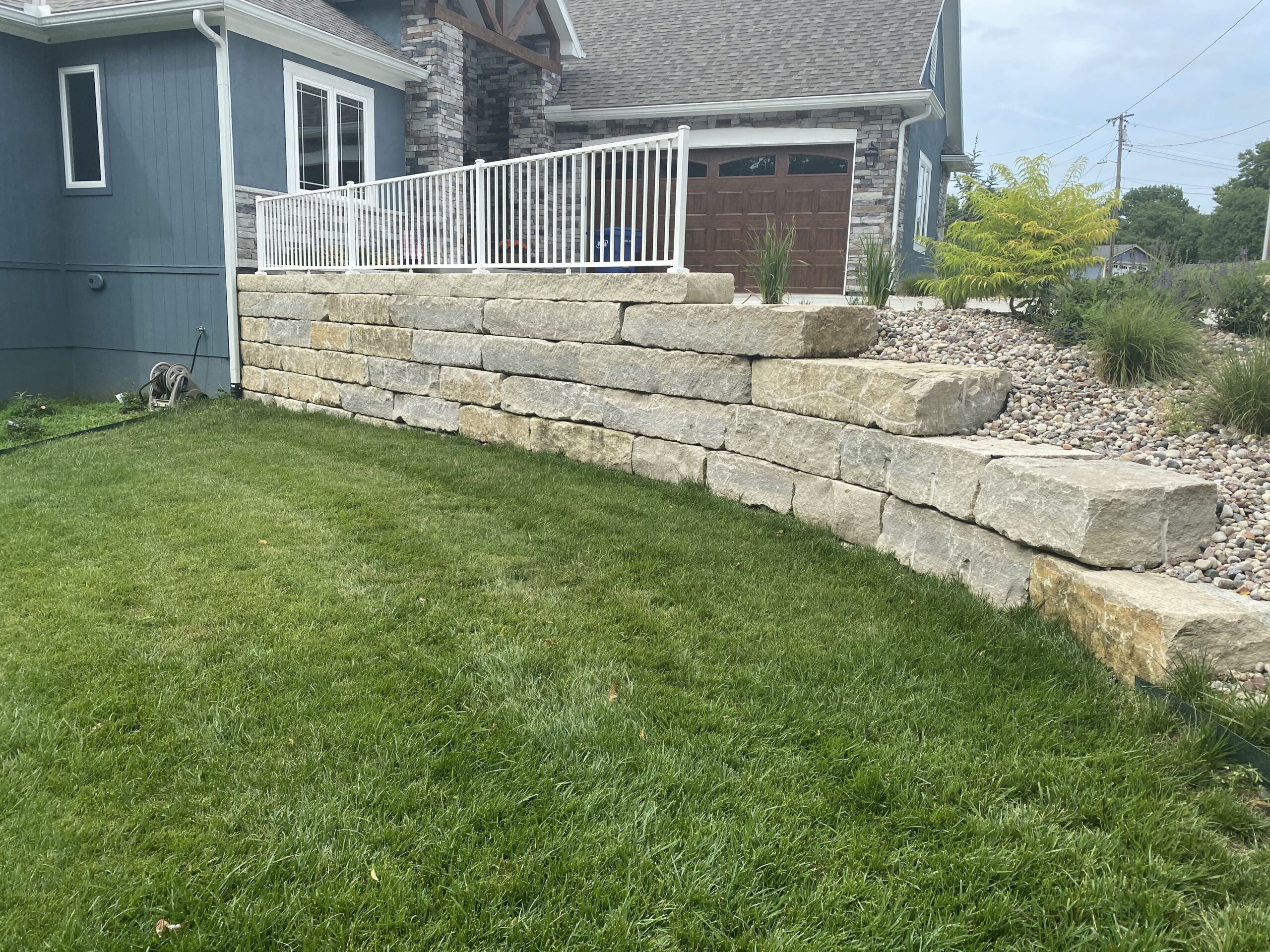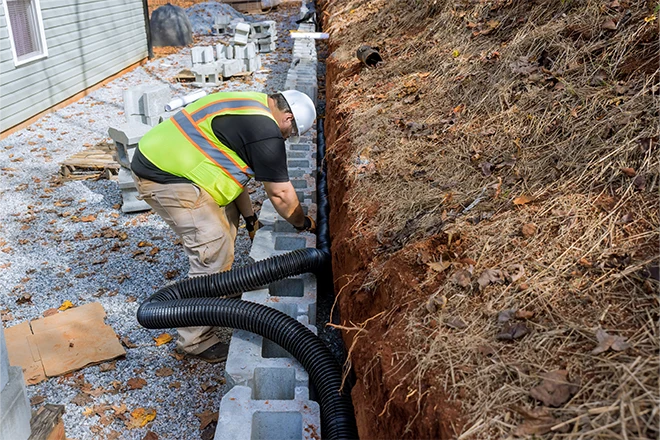The Best Wall For Creating The Best Space
Have you ever wondered how you can enhance the landscape of your home while preventing soil erosion? Curious about which types of retaining walls are best suited for your needs?
In this comprehensive blog post, we will explore the various retaining wall types, their uses, and their pros and cons. By the end of this post, you’ll have a solid understanding of the best retaining wall options for your home, and how they can help to create a stunning and functional landscape.
Popular Retaining Wall Types in Kansas City, Missouri

In Kansas City, Missouri, homeowners often face challenges with sloping terrain, heavy rainfall, and clay-rich soil. Some of the most popular retaining wall types in this region include:
- Gravity Retaining Walls – Their versatility and aesthetic appeal make them a popular choice for creating tiered gardens and supporting slopes.
- Crib Walls – These walls are ideal for steep slopes and can accommodate vegetation growth, making them an environmentally friendly option.
- MSE or Reinforced Soil Retaining Walls – Due to their ability to handle large loads and heights, these walls are often used to support driveways or retain slopes in residential areas.
- Cantilever Retaining Walls – With efficient use of materials and the ability to support taller retaining walls, cantilevered retaining walls are a common choice for creating space for outdoor living areas or tiered gardens.
Remember to consult with a professional before selecting and installing a retaining wall to ensure that it meets your specific needs and local building codes.
10 Types Of Retaining Walls
| Retaining Wall Type | Homeowner Landscape and Home Improvement Applications |
| Gravity Retaining Walls | Garden terraces, supporting sloped lawns, outdoor living spaces |
| Crib Walls | Steep slopes, terraced gardens, landslide stabilization |
| Gabion Walls | Slope stabilization, garden beds, unique landscape features |
| Bin Walls | Leveled areas for outdoor living spaces, supporting steep slopes |
| Mechanically Stabilized Earth (MSE) | Supporting driveways, retaining slopes, tiered landscapes |
| Cantilever Retaining Walls | Limited space, taller retaining walls, tiered gardens |
| Buttressed Walls | Higher loads, taller retaining walls, landslide stabilization |
| Anchored or Embedded Retaining Walls | Excessive pressure, limited space, outdoor living spaces |
| Sheet Piling or Piled Retaining Walls | Preventing soil erosion, waterfront properties, supporting slopes |
| Combination Retaining Walls | Customized solutions for various site conditions, unique landscape features |
1. Gravity Retaining Walls
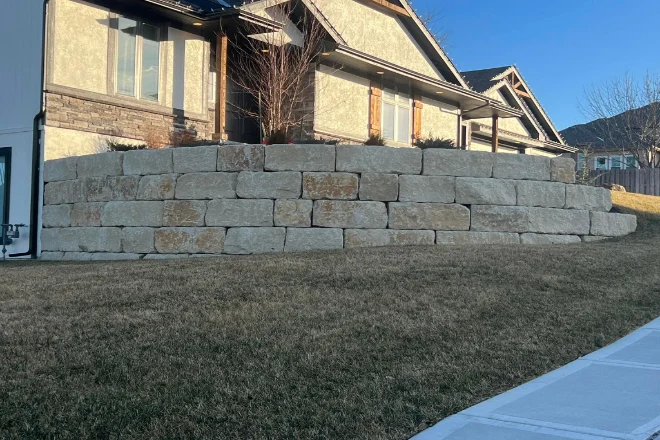
A gravity retaining wall uses the weight of the wall itself and the force of gravity to hold back the soil. They are typically made from materials such as concrete blocks, stone, or brick masonry.
This type of retaining wall is popular for its aesthetic appeal and can be used to create garden terraces, support sloped lawns, or create space for outdoor living areas.
Pros:
- Simple construction
- Can be built with various materials
- Aesthetically pleasing
Cons:
- Limited height (usually not suitable for taller retaining walls)
- May require additional support for higher loads
*The retaining walls Gradex Co builds are mainly stone gravity walls.
2. Crib Walls

Crib walls are interlocking structures made from precast concrete or timber. They create a stable and attractive retaining structure by filling the cells with crushed stone or soil.
Crib walls are suitable for steep slopes, creating terraced gardens, or stabilizing areas prone to landslides.
Pros:
- Allows for vegetation growth
- Suitable for steep slopes
- Good drainage
Cons:
- Timber crib walls may rot over time
- Requires periodic maintenance
3. Gabion Walls
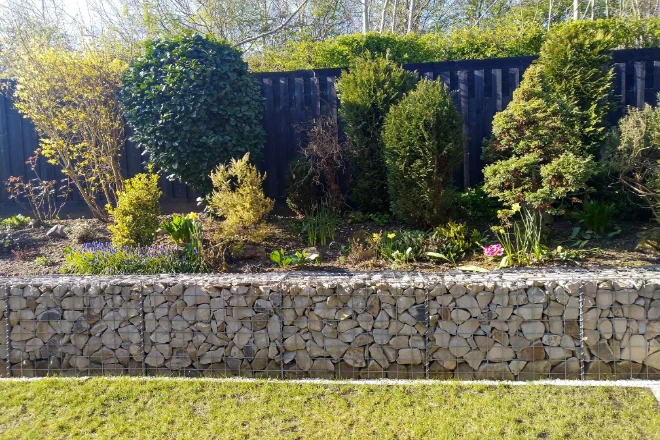
Gabion walls consist of wire mesh baskets filled with rocks or stones. They’re often used to stabilize slopes, create garden beds, or protect against soil erosion.
Gabion walls can also be used to create unique landscape features, such as seating areas, planters, or decorative elements.
Pros:
- Highly permeable
- Environmentally friendly
- Can be easily installed
Cons:
- May not be visually appealing to everyone
- Wire mesh may corrode over time
4. Bin Walls
Bin walls are made from interconnected steel or concrete bins, filled with compacted soil or crushed stone.
This type of retaining wall is commonly used for car parks and highway construction but can also be used in residential settings to create leveled areas for outdoor living spaces or to support steep slopes.
Pros:
- Can accommodate higher loads
- Easy to assemble and disassemble
- Good for large-scale projects
Cons:
- Not as visually appealing as other wall types
- May require specialized equipment for installation
5. Mechanically Stabilized Earth (MSE) Or Reinforced Soil Retaining Walls
MSE walls are constructed by combining layers of soil with geosynthetic reinforcement materials, such as geogrids or geotextiles.
A reinforced retaining wall can support higher loads and are suitable for taller retaining walls, making them ideal for supporting driveways, retaining slopes, or creating tiered landscapes.
Pros:
- Can handle large loads and heights
- Cost-effective
- Good for roadways and bridge abutments
Cons:
- Requires skilled labor for installation
- May require more maintenance than other wall types
6. Cantilever Retaining Walls
Cantilever retaining walls are reinforced concrete structures that use a base slab and stem to resist lateral earth pressure.
A cantilever retaining wall is suitable for situations with limited space and can be used to support taller retaining walls, provide space for outdoor living areas, or create tiered gardens.
Pros:
- Can accommodate higher loads
- Efficient use of materials
- Requires less excavation than other wall types
Cons:
- Requires skilled labor and engineering
- Not as visually appealing as some other wall types
7. Buttressed Walls
Buttressed walls are similar to cantilever retaining walls but include counterforts, which provide additional support to the wall.
These walls are suitable for situations with higher loads and can be used to support taller retaining walls or to stabilize areas prone to landslides.
Pros:
- Can handle higher loads
- Good for taller retaining walls
- Efficient use of materials
Cons:
- Requires skilled labor and engineering
- Not as visually appealing as some other wall types
8. Anchored Or Embedded Retaining Walls
Anchored retaining walls use anchors driven into the ground to provide additional support. These walls can be constructed from various materials, such as concrete or steel, and are suitable for areas with excessive pressure or limited space.
You can use an anchored retaining wall to create space for outdoor living areas, support steep slopes, or protect against soil erosion.
Pros:
- Can handle higher loads
- Suitable for a wide range of soil conditions
- Versatile construction options
Cons:
- Requires specialized equipment and skilled labor
- Can be more expensive than other wall types
9. Sheet Piling Or Piled Retaining Walls
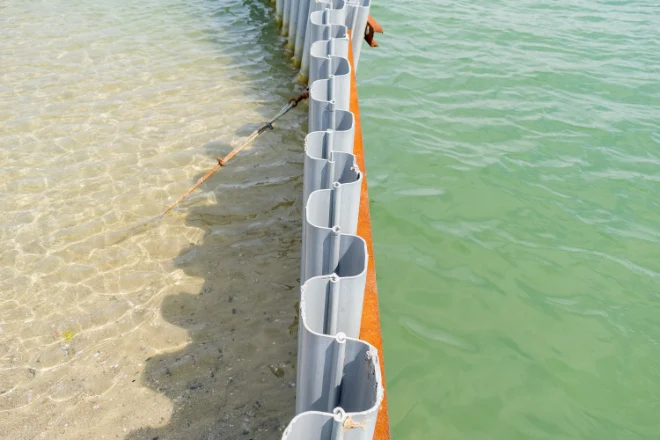
Sheet pile retaining walls are constructed by driving thin, interlocking steel or vinyl sheets into the ground. They are best suited for areas with soft soil and limited space, making them ideal for waterfront properties or areas with high water tables.
Sheet pile walls can be used to prevent soil erosion, create space for outdoor living areas, or support slopes.
Pros:
- Efficient use of space
- Can handle a variety of soil conditions
- Relatively low installation cost
Cons:
- May not be suitable for taller retaining walls
- Not as visually appealing as some other wall types
10. Combination Retaining Walls
Combination retaining walls utilize two or more retaining wall types, such as a gravity wall with anchors or a cantilever wall with a mechanically stabilized earth system.
These walls can be customized to meet specific site requirements and provide optimal performance.
Combination walls can be used to create unique landscape features, support slopes, or protect against soil erosion.
Pros:
- Offers flexibility in design and construction
- Can handle a variety of site conditions
- Can combine the advantages of different wall types
Cons:
- Can be more complex to design and install
- May require additional engineering and labor
See what our retaining walls have done to improve people’s landscaping in and around Kansas City, MI.
Gradex: Your Partner in Building the Perfect Retaining Wall
We hope this guide has provided you with valuable insights into the different types of retaining walls and their best uses around your home.
Gradex is here to help you choose and install the perfect stone retaining wall to enhance your landscaping and protect your home from soil erosion.
Fill out our contact form today, or give us a call to get started on your next retaining wall project.
